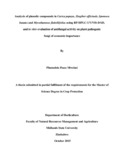Please use this identifier to cite or link to this item:
https://cris.library.msu.ac.zw//handle/11408/2573| Title: | Analysis of phenolic compounds in Carica papaya, Zingiber officinale, Ipomoea batatas and Myrothamnus flabellifolius using RP-HPLC-UV/VIS-DAD, and in vitro evaluation of antifungal activity on plant pathogenic fungi of economic importance | Authors: | Mwelasi, Phumelela Peace | Keywords: | Agricultural pesticides | Issue Date: | 2015 | Publisher: | Midlands State University | Abstract: | Agricultural pesticides use is rising in crop protection against plant invaders of which fungi are chief in reducing both yield quantity and quality. Botrytis cinerea, Rhizoctonia solani, Macrophomina phaseolina and Alternaria alternata are polyphagous fungi of economic importance with severe yield and quality losses worldwide. Environmental concerns on pesticide use and their resistance now on a worldwide scale. Extensive studies of plant secondary metabolites have not exhausted their potential use as natural crop proctetants. The antifungal activity of plant phenolic extracts: Carica papaya leaves and bark; Zingiber officinale rhizomes; Myrothamnus flabellifolius above ground parts; and Ipomoea batatas leaves were investigated on the plant pathogenic fungi. Methanol (80%) was used to extract phenolic compounds from dried samples. Qualitative and quantitative analyses of extracts were done through Reversed-Phase High Performance Liquid Chromatograph, Ultraviolet-Visible light Diode Array Detector (RP-HPLC-UV/VIS-DAD) analyses. In antifungal in vitro assays, Potato Glucose Agar (PGA) in petri dishes was incorporated with three concentrations 250 ppm,500 ppm and1000 ppm) of sample plant phenolic compounds and active ingredients of fungicides (as positive controls); the negative controls were incorporated with diluent used to reconstitute plant phenolic compounds. The study was laid in a 7 x 3 factorial treatment in a completely randomized design replicated three times with the two factors being plant phenolic extracts and extract concentration. A 6mm diameter disc of the 7-day old pure fungi culture cultivated on PGA was aseptically inoculated at the centre of the petri dish for each treatment and petri dishes incubated at 20±2°C (B. cinerea) and 26±2°C (R. solani, M. phaseolina and A. alternata). Mycelial growth (diameter) measurements (in mm) were taken at 24hour exposure and stopped upon full colony diameter (85mm) observation in the negative control plates. Quantitative RP-HPLC-UV/VIS-DAD analyses yielded a strong peak at a Retention Time (RT) =1.01min for Ipomoea batatas however this could not be elucidated. Other extracts produced nondescript chromatograms that were not similar to standard phenolic compounds RTs. There were significant differences (ρ ˂ 0.05) in Total Phenolic Content of plant phenolic extracts yields (mgGAE/g), 55.7±2.2, 7.0±3.3, 106.1±12.0, 33.5±3.4, and 41.9±1.5 for C. papaya leaves, bark, Z. officinale, M. flabellifolius and I. batatas respectively. Phytochemical test results were varied amongst plant phenolic extracts, mostly being positive. Antifungal in vitro assays, plant phenolic extract and extract concentraction interacted significantly (all ρ ˂ 0.05) at all the time intervals for all the species except for B. cinerea 96 hours interval where only the plant phenolic extract were significant (ρ ˂ 0.05) whilst there was no significant interaction of the two factors. The interaction of the two factors showed varied results in their inhibition of mycelial growth with differences amongst plant phenolic extracts and fungi species noted. Percentage Mycelial Reduction (PMR) varied amongst phenolic extracts and phytopathogenic fungi. Generally, the phenolic extracts showed less antifungal activity compared to the positive control treatments (fungicides). Carica papaya bark and Z. officinale rhizomes showed the highest PMR against M. phaseolina (30%≤PMR≤40%) at the 1000 ppm concentration. Z. officinale showed the highest PMR (45.3%≤PMR≤ 54.7%) for all the concentrations on A. alternaria. M. flabellifolius showed the highest PMR (26.5%≤PMR≤53.9%) for all the three concentrations on R. solani. Only M. flabellifolius had limited PMR of 0-5.9%, whilst other plant phenolic extracts showed a 0% PMR agaist B. cinerea. The result of PMRs shows that plant phenolic extracts have potential use in vivo as crop protectants however further research may consider reduced fungicide dosages by using both synthetic and plant phenolic extract as mixtures. | URI: | http://hdl.handle.net/11408/2573 |
| Appears in Collections: | Masters Of Science In Crop Protection |
Files in This Item:
| File | Description | Size | Format | |
|---|---|---|---|---|
| Final Thesis-Peace 2015-Reviewed.pdf | Full Text | 3.03 MB | Adobe PDF |  View/Open |
Page view(s)
278
checked on Nov 23, 2025
Download(s)
164
checked on Nov 23, 2025
Google ScholarTM
Check
Items in MSUIR are protected by copyright, with all rights reserved, unless otherwise indicated.



